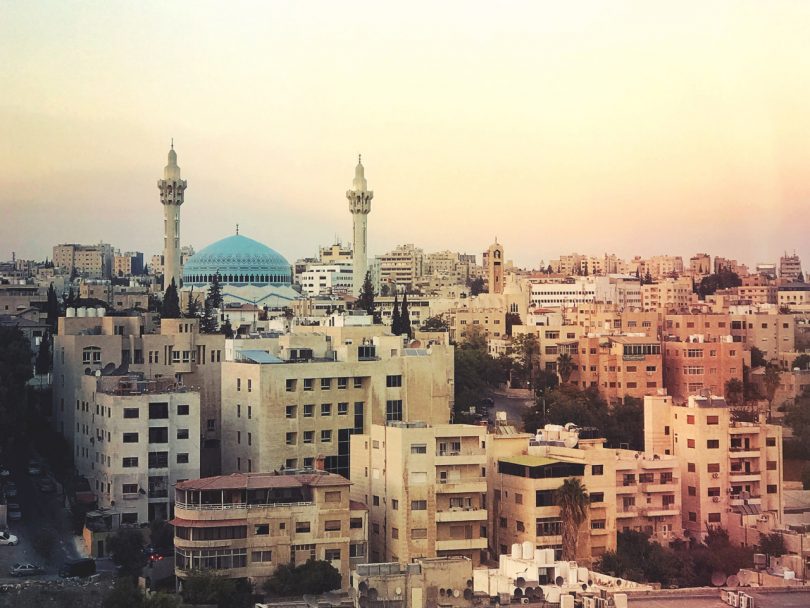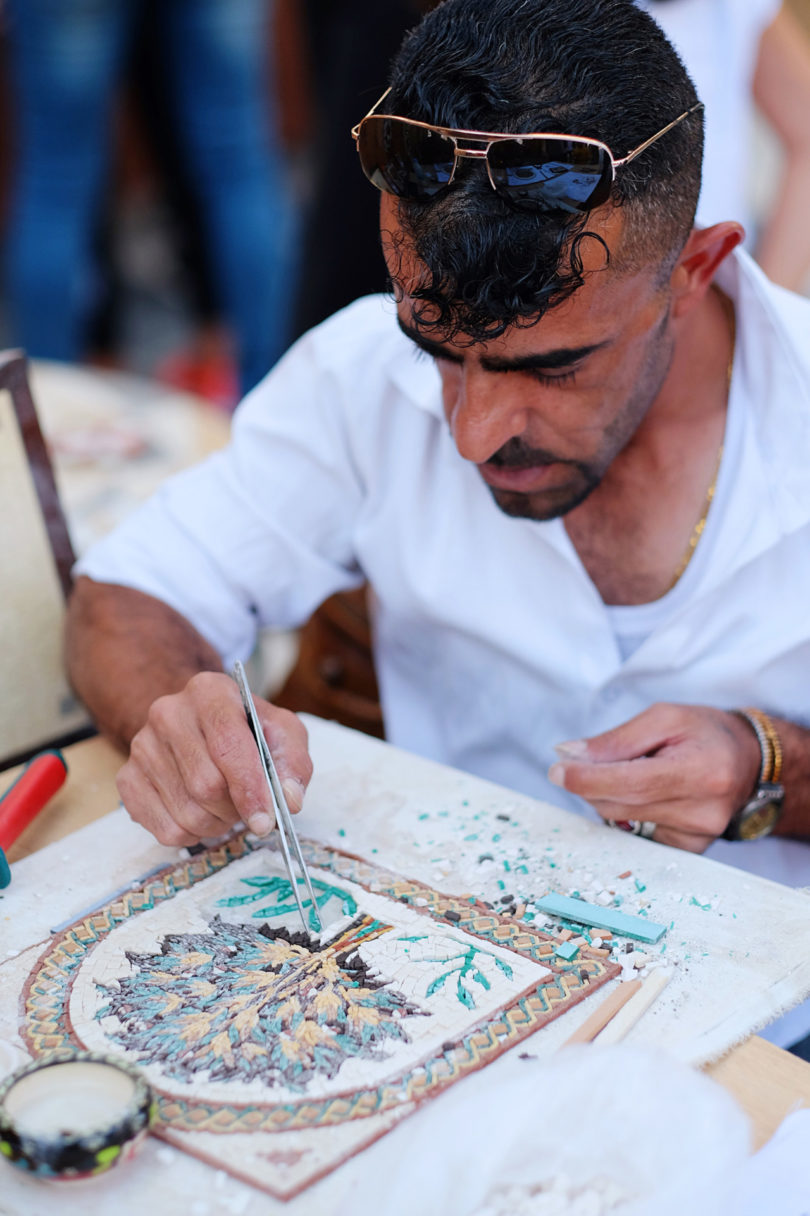The seven main hills of Amman stand sentinel to one of the oldest continuously inhabited cities in the world, one buzzing with the telltale signs of modernity at its core accompanied with the haunting hum of antiquity interspersed along its periphery. Tourists arrive in droves for short stays here within the capital of Jordan before heading out with plans for days to be spent floating weightlessly upon the saline buoyancy of the Dead Sea or navigating the achingly beautiful narrow passage into the heart of the ancient Nabataean city of Petra by foot. But in doing so, visitors forgo the opportunity to explore a city beginning to embroider the tapestry of its ancient past with a emerging art and design scene.
WHERE TO STAY
Motivated by hunger, my first morning in Amman was spent huffing and puffing up and down a series of serpentine streets, each interconnected to a see-saw of stairs. Imagine someone throwing a plateful of noodles onto paper and tracing the outlines to map a city, and you’ve got an approximation of Amman’s dizzying streets. I endured the Sisyphean butt-kicker in hopes of finding Salaheddin Bakery (مخبز صلاح الدين), an Abdali neighborhood staple specializing in kaek, a fingertip-scorching loaf of freshly baked sesame seed encrusted bread impregnated with a holy trinity of baked eggs, cheese, and za’atar. Perhaps it was a case of positive reinforcement by way of taste buds after devouring that unforgettably delicious sandwich, but afterward I felt confident and committed to exploring Amman by foot. Obviously a level of fitness is required to walk such demanding geography, but the reward is the ability to scratch the itch of curiosity tickled by Amman’s countless alleys, courtyards, and hidden gardens.
Staying at a hotel central to downtown is advisable for this purpose, allowing easier access to Amman’s historical sites, the souk, galleries, shops, and restaurants. Even so, be ready to jump into one of the 11,000 yellow taxis servicing Amman.
La Locanda Boutique Hotel, Jordan’s first themed boutique hotel, is nestled in the precipitous and picturesque neighborhood of Jabel Al Weibdeh, the artistic heart of Amman. The hotel is close to many of the city’s most vibrant galleries, most notably the center for contemporary Arab art, Darat Al Funun. The tree-lined avenues dotted with shops and cafes allow for leisurely walks with the opportunity to frequently stop.
Don’t let the name throw you off, the Wild Jordan Center is a hidden gem and our favorite accommodations for longer stays in Amman. Comprised of five “lodges” (really just apartments, complete with kitchenettes), the center offers guests an Instagram-worthy view overlooking Old Amman, with the iconic Citadel clearly visible from every window and balcony. The lodges are named after nature reserves protected by the Royal Society for the Conservation of Nature. With the evocation of a lodge, one might expect rustic decor, but each room is actually decorated in contemporary furnishings. The adjoining restaurant serves visitors and guests alike local seasonal fare served with a health conscious bent; nearly every table presents a densely populated and picturesque view of city life below. I also remember the adjoining gift shop as particularly well stocked with small wares, clothing, handmade items, and foodstuffs.
Those seeking the refuge of a recognizably global style of accommodations may find the contemporary 280 guest rooms and 44 suites of the W Amman in the Abdali neighborhood to their liking. If you’ve stayed at a W Hotel before, the financial district hotel won’t throw any surprises, sharing the identifiably sleek W-style décor that has made the brand a dependable beacon for vacationers and business travelers alike.
Notable mentions: Four Seasons Hotel Amman \\ The House Boutique Suites \\ Grand Hyatt Amman \\ The Art Hotel
WHERE TO PLAY
The Jordanian National Gallery of Fine Arts’ collection of contemporary art isn’t comprehensive, but it offers an excellent starting off point with a curated selection showcasing the diversity of styles, techniques, and subject matter specific to Jordan and the surrounding regions. The museum is actually comprised of two buildings separated by a sculpture garden in between, with temporary exhibitions housed in the smaller north side Building 1, with the majority of its permanent collection housed across inside Building 2. The neighborhood and museum are both surprisingly quiet, delivering unhurried contemplation and appreciation of the artwork on display.

“A Chair Tale” exhibition during Amman Design Week at the Jordan National Gallery. Photo: Gregory Han
The Darat al Funun could be considered the Jordanian equivalent of The Getty in Los Angeles – a hillside cultural center dedicated to the intersection of contemporary and ancient art, academia, and cultural outreach overlooking its host city. But how many museums can claim its own excavated ruins of a 6th-century Byzantine church sitting on its grounds? Just be ready to climb an endless ascension of stairs while exploring Darat al Funun’s intimate gardens, library, temporary exhibitions, and hopefully a stop at the hillside cafe. Each spot rewards curious minds with strengthened calves.
Tiraz sits on the outskirts of a residential section of Amman, and inside its unassuming walls resides the magnificent Widad Kamel Kawar dress collection, the most complete assemblage of both Palestinian and Jordanian dress, alongside the largest collection of Syrian dresses outside of the country. A deeper appreciation of the region and its people is revealed in inspection of the dizzying intricacy decorating the collection’s dresses, each fashioned to communicate the extended history of its wearer and their community through the craft of detailed embroidery. The museum also hosts temporary exhibits; during our visit the intricate pixel-like geometry of Jordanian designers Nisreen and Nermeen Abu Dail of Naqsh Collective greeted visitors from the courtyard, with a more extensive display within.
Arini is the physical outpost of the Arabic online architecture and design site, Herskhazeen, and one of the more important institutions focused upon the promotion, dialogue, and investigation of contemporary design and architecture in the Middle East. Visitors are bound to discover an ever-changing landscape of immersive installations like Dalieh – the Kinetic Canopy [shown above], alongside operating as a nexus of the city’s creative class.
Notable mentions: Mujib Chalets \\ Wild Jordan Center \\ Feynan Ecolodge
WHERE TO SHOP
When we slipped into Turbo for a breather during Amman Design Week, we weren’t quite sure what to make of the former abandoned car repair shop outfitted by graphic designers Saeed Abu-Jaber and Mothanna Hussein. Was it a graphic design studio? A coffee bar? A gallery? A pop-up shop? The answer is simply, “yes” (and also the answer to whether you should drop in). Their multidisciplinary studio is most easily spotted by their bright yellow espresso machine and an iconic tiger sculpture.
After spending an afternoon sampling Kama’s selection of gourmet local olives, oils, spices, nuts, chocolates, and snacks – each packaged in elegant contemporary Arabic geometric motifs – our evening was spent valiantly attempting to find extra room in our luggage to bring back home an assortment of gifts. Kama’s delicious design is a choice opportunity to bring back a taste of Jordan (or enjoy some in your hotel room, as I might be guilty of).
Home décor, flowers and plants, food, and even a weekly yoga class all intersect at Shams Amman and their adjoining Al Balad Café. I discovered the shop after looking for the intricate and colorful art of Mo Rusan, whose arabesque prints would not look one bit out of place in a William Morris catalog.
Jordan River Foundation has two outposts – one inside the city and another within the Queen Alia International Airport, conveniently located just before the security gates at the departure lounge. Both represent the non-profit efforts of Her Majesty Queen Rania of Jordan, each designed to spotlight a vibrant catalog of modern home décor and accessories handmade using traditional embroidery and woodworking techniques. Proceeds go to funding training programs to empower local women and children, making it destination for conscious consumerism.
Notable mentions: Tumayr – Garden Shop \\ Jordan Craft Center \\ Jacaranda
FINAL WORDS
Upon arrival, Amman can seem like an overwhelming tangle of sights, sounds, smells, and textures. But by carefully pre-populating a Google Map with sights to visit, that seemingly impenetrable mass reveals a very walkable city. Download the rideshare app, Careem, and connecting those dots on your to-do list becomes even easier.
Amman Design Week is only in its second year of existence, but what it lacks in history it makes up for in its immersive breadth, exploring design beyond the esthetic and deep into the realm of relevant social, cultural, and environmental issues. Examples include ‘Kutleh’ by Rula Yaghmour (left) a “carved” seat made with scraps from the stone industry and construction projects, and ‘Left of Passage, Right of Passage’ (right), an installation by Anmahian Winton Architects, inspired by Wadi Rum, the geological Jordanian wilderness immortalized by T E Lawrence as “vast, echoing and godlike”. A visit scheduled during this celebratory span presents Amman at its most festive and finest from an arts and design perspective.
from Design MilkDesign Milk https://design-milk.com/design-milk-travels-amman/
from Home Improvment http://notelocreesnitu.tumblr.com/post/176342247244




















No comments:
Post a Comment